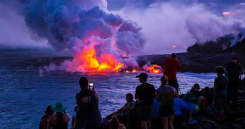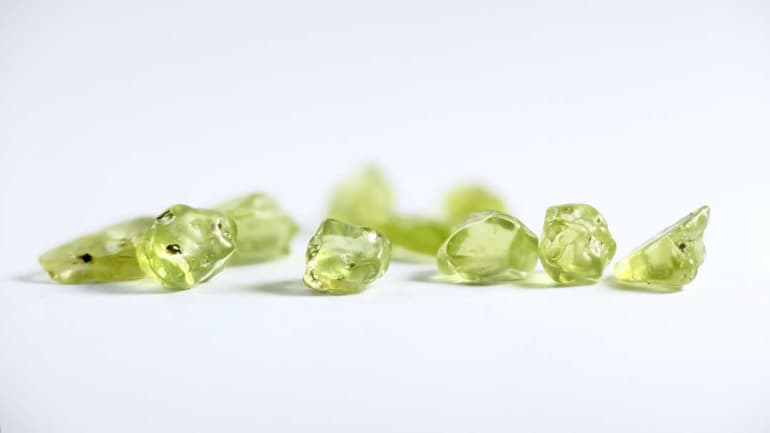Recent stories reported Kilauea eruptions causing gemstones to rain from Hawaii skies. Updated reports reveal that it’s actually a mineral called olivine and it’s more common than initially thought.
If you’ve followed news regarding the eruption of Kilauea on the Big Island of Hawaii, you already know the news about olivine. If you aren’t following closely, you might have heard that gemstones are raining from the sky in the areas surrounding the active volcano. The gemstone reports originated from a tweet posted by a user who identified themselves as a meteorologist.
Some news outlets quickly snatched the story up, filling up timelines and newsfeeds with reports that Kilauea’s eruption caused olivine gemstones to rain down. Geologists soon followed up with investigations and their own reports, debunking these gemstone claims soon after.
If you haven’t followed the eruption of Kilauea at all, though, you might be a bit lost. Erupting volcanoes might sound like something truly terrifying if you don’t understand what’s actually taking place. Continue reading to learn more about Kilauea’s eruption, the impact of the lava flows, and the reports of olivine gemstones falling from the sky.
The Recent Eruption of Kilauea
Kilauea is one of five volcanoes on the Big Island of Hawaii. Scientists consider the first of the five, Kohala, extinct as it last erupted over 60,000 years ago. Mauna Kea’s last eruption was more than 3,000 years ago, classifying it as dormant.
Hualalai, Mauna Loa, and Kilauea are each considered active, with Kilauea erupting most recently out of the three. Starting at the beginning of May, plumes of ash began to billow from the top of the volcano. Lava spread quickly and raised alarm among many people without close connections to Hawaii.
Dozens of news outlets immediately began to cover the story. Pictures of lava flows covering streets and houses spread across the internet. People didn’t feel safe traveling to Hawaii and feared their visit might be impacted by the volcano’s eruption.

How far has the damage from the recent Kilauea eruption stretched?
More infoHow Widespread is Kilauea’s Lava Flow?
Some outlets portray the impact of the eruption as more widespread than it actually is. If you’ve only seen pictures and are not familiar with Hawaii, it might seem like the destruction is incredibly widespread. Although the existing damage cannot be discounted it is not as large as it may seem.
To put it into perspective, the Big Island as a whole expands more than 4,000 square miles. The current damage of Kilauea’s lava flow extends 9.6 miles, not even a full percent of the island’s total landmass.

How far has the damage from the recent Kilauea eruption stretched?
Rest assured: Hawaii Island Recovery is a safe place to seek treatment and help.
The lava flows spouting from Kilauea still remain on the eastern side of the island. Locations on the west side, home to places like Hawaii Island Recovery, still remain safe and non impacted by the eruption. Media outlets do their best to cover stories accurately but they cannot stop the panic caused by people who do not do their research.
Olivine Skies: The Olivine Gemstone Rains
The falsely-reported olivine gemstones raining from the sky are another example of the frenzy that news stories quickly whip up. News reports latched onto a single image posted by a Twitter user. Outlets as large as USA Today and Forbes reported the phenomena of green crystal “rain” coming from the Kilauea eruption.
Geologists quickly looked into the situation and determined these crystal rains were actually a mineral called olivine. Within a week, most outlets attached updated prefaces to their initial stories. In actuality, olivine crystals are found in the lava emitted from Hawaii’s volcanoes. It is so common that multiple beaches across the islands shine with a green tint due to the high concentration of olivine in their sands.
Olivine is called peridot when it is of true gemstone quality. The clear green crystals seen online are hardly of the quality jewelers need to set into a ring. The shiny green crystals clutched in many hands pictured across social media channels are not “fresh” olivine gemstones from the volcano. In reality, the volcanic mineral often isn’t gemstone quality at all.

The eruption of Kilauea on the Big Island brought the olivine mineral to the public eye.
When it first emerges from a volcanic eruption, olivine is deeply embedded within the volcanic rock. As the lava rock that encases it slowly erodes away, the crystals are initially grey in color. The ashy covering wears away after years of weathering to finally show off its inner glittering green color.
Claims that these handfuls of green minerals are raining from the current eruption are far from true. Still, they do not dissuade from the beauty that expands across the Big Island of Hawaii. Spread across the many beaches in Hawaii, olivine in its natural state is truly a sight to behold, whether or not it emerged from the most recent volcanic eruption.

Dark, steamy, a beautiful orange glow just over the horizon. This is Kilauea Volcano which has been erupting non-stop since 1983.
More infoIs It Safe to Travel to Hawaii?
Seeing as the majority of the island is still largely untouched by lava, Hawaii is still safe to travel to. The United States Geological Service recently downgraded the alert level regarding the eruption of Kilauea to Orange. Though emissions nearby remain at high levels, the further surrounding areas are not as impacted.
Locations like Hawaii Island Recovery have not been affected by the impact of Kilauea’s eruption. If you are looking for an addiction treatment center in Hawaii, Hawaii Island Recovery is the facility for you. Call our admissions office at 877-721-3556 to learn more about the treatment options we offer.
 Hawaii Island Recovery
Hawaii Island Recovery 










